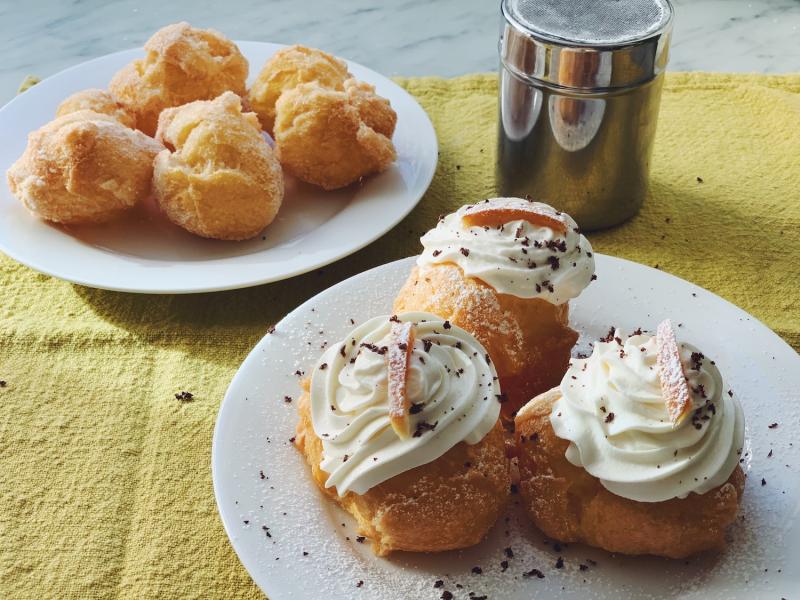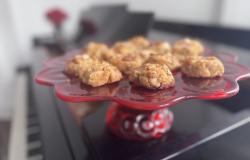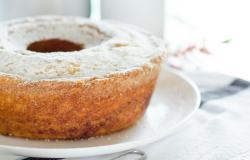Sfince di San Giuseppe

The Feast of St. Joseph, which falls every year on March 19, is a big deal in Italy. Not only does the holiday commemorate the putative father of Jesus and patron saint of carpenters; it is a celebration of all fathers—Italy’s version of Father’s Day—and of spring’s long-awaited return.
In Sicily, which claims St. Joseph as its patron saint, the day is met with genuine ardor. There are parades and processions; in churches and in homes, three-tiered altars are assembled and adorned with fruit and ornately decorated loaves of bread.
And there are pastries. Not surprisingly, the region that gave the world cannoli and hand-painted marzipan fruit has a pastry dedicated to the celebration of its patron saint. That pastry is sfince, pronounced “sfeen-chay.” Or, to put it another way: fried cream puffs.
Sfince are similar to Neapolitan zeppole, but rather than piped into rings and filled with pastry cream, they are filled with sweetened ricotta cream and garnished with crushed pistachios and candied citrus.
The word “sfince” (sometimes spelled ‘sfinci’ or ‘sfingi’) means ‘sponge,’ and is believed to have Arab origins. Arabs ruled Sicily for more than a century (before being defeated by the Normans in the 11th century), and they are credited with giving Sicilians their taste for desserts and introducing ingredients such as pistachios, almonds, cinnamon, citrus, and sugar. Later, in the 1800s, Swiss pastry chefs who immigrated to southern Italy and opened pastry shops in Naples and Palermo, introduced butter and cream.
The sfince reflects both traditions. The batter for the pastry, a mix of butter, water and flour cooked on the stovetop and then enriched with eggs, is, essentially, choux—the same thick paste used to make cream puffs or their savory counterpart, gougères.
If there is a challenge to making sfince, it is in the frying. If the oil is too hot, the pastry will brown on the outside, but inside the dense batter will be undercooked. The key is to keep the frying oil to about 340° F (170° C) and to leave the puffs in for a good 5 to 6 minutes. Starting around the 2-minute mark, they will slowly but surely begin to expand, eventually tripling in size and splitting open a bit as the water in the batter turns to steam. They may even turn over by themselves as they inflate. Bobbing in the oil, they look a bit like little blowfish.
Like so many fried treats, sfince are best soon after they emerge from their oil bath. Biting into a still-warm sfincia rolled in sugar is the best way to savor both its delicate, crispy exterior and its airy, tender, slightly eggy interior. Then again, there is much to be said for the more lavish, ricotta-filled version. Use the freshest ricotta you can find to make the cream, and make sure it’s well drained, so that it whips up light and fluffy but still retains some body.
Finally, don’t forget a pretty garnish—a strip of candied orange, a glacéed cherry, a shower of crushed pistachios or even shaved chocolate. Now that’s a pastry worthy of a celebration.
This recipe makes about 15 sfince
Make the Ricotta Cream: Combine all the ingredients in a stand mixer fitted with the whisk attachment. Beat, first on low, then on high, until the cream is stiff and fluffy. Transfer to a bowl, cover tightly, and refrigerate until ready to use.
Make the Sfince: Combine the water, butter, and salt in a medium, heavy-bottomed saucepan and set over medium heat. Cook, stirring, until the butter is melted, then raise the heat to high and bring to a boil. Remove the pot from the heat and dump in the flour all at once. Stir vigorously with a wooden spoon or silicone spatula until the mixture comes together in a rough mass. Return the pot to the heat and cook, stirring constantly, on medium-low for a minute or so, until the mass has formed a smooth, soft, ball of dough the color of almond paste. Transfer the dough into the work bowl of a food processor or stand mixer fitted with the whisk attachment, and let cool for 15 minutes.
Pulse or mix the dough briefly to break it up, then add the eggs, one at a time, and process or mix until smooth. You’ll end up with a smooth paste that is somewhere between dough and batter, dense and sticky, like a thick homemade mayonnaise. Scrape the mixture into a bowl. Lightly coat a sheet of plastic wrap with thin film of sunflower (or vegetable) oil and place it directly over the batter. Let it rest while you heat the oil.
Have ready a baking sheet or platter lined with paper towels. Heat 2 to 3 inches of oil to medium-hot (340° F / 170° C) in a medium, high-sided saucepan. The oil should not be too hot; otherwise the sfince will brown on the outside before they are fully cooked. The depth of the oil is also important, as the dollops of batter will expand greatly as they fry. When the oil is ready, drop two or three walnut-sized nuggets of batter into the pot. I use two spoons ~ one to scoop up the batter and the other to scrape it into the oil. Fry the sfince, turning them every so often with a fork or the edge of a spider, for 5 to 6 minutes. It will take them this long to inflate (and, in some cases, partially split) into fully cooked, airy puffs. Transfer the sfince to the paper towel-lined baking sheet. Fry the remaining sfince, a few at a time, and drain them on the paper towels.
To fill the sfince, fill a pastry bag fitted with a plain or star tip with the prepared ricotta cream and fill the puffs generously so that a cap of cream overflows. Or use a spoon to fill them and frost the tops. Garnish each pastry with a glacéed cherry or candied orange peel and a little shower of grated chocolate or chopped pistachios.
Note: You can also enjoy the sfince plain, without filling. Just roll them in granulated sugar as they come out of the fryer and eat them while they are still warm.





